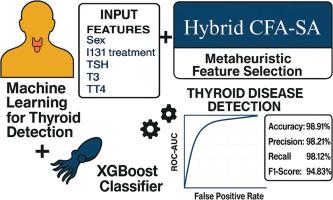A novel hybrid approach for thyroid disease detection: Integrating cuttlefish algorithm and simulated annealing for optimal feature selection
IF 1.9
Q2 MULTIDISCIPLINARY SCIENCES
引用次数: 0
Abstract
Effective treatment relies on a timely diagnosis, which is critical in the case of thyroid disorder—one of the chronic endocrine disorders alongside diabetes and obesity—with profound health concerns. Thyroid disorders occur due to the malfunctioning of the thyroid gland, which may result in an imbalanced metabolic rate due to inappropriate hormone levels synthesis. An overactive gland results in hyperthyroidism, whereas an underactive or sluggish thyroid lead to hypothyroidism. Both disorders, if not detected and managed timely, can lead to severe health complications. Early identification is crucial to delay or avoid debilitating complications and achieve a better quality of life through the right medical interventions and precise hormonal readjustments. The proposed hybrid algorithm method finds the best features for finding thyroid disease uses performance measures such as accuracy, F1-score, precision, and recall. The research demonstrates promising results with an accuracy of 98.91 % and an F1-score of 94.83, showcasing the robustness of the proposed algorithms on a benchmark dataset. The findings hold potential to improve clinical decision-making processes. This study advances medical diagnostics by combining machine learning algorithms with nature-inspired optimization techniques to detect thyroid illnesses in their early stages.
- •This article proposes a novel hybrid algorithm that combines the Cuttlefish Optimization Algorithm (CFA) and Simulated Annealing (SA) to find the best features for finding thyroid disease.
- •The study uses machine-learning models for classification.
- •The integration of machine learning and nature-inspired optimization significantly enhances the diagnostic capabilities of healthcare systems, enabling prompt diagnosis and treatment planning for thyroid disorders.

一种新的甲状腺疾病检测混合方法:融合墨鱼算法和模拟退火的最优特征选择
有效的治疗依赖于及时的诊断,这对甲状腺疾病至关重要,甲状腺疾病是与糖尿病和肥胖一起的慢性内分泌疾病,具有严重的健康问题。甲状腺疾病的发生是由于甲状腺功能失常,这可能导致代谢率不平衡,由于不适当的激素水平合成。过度活跃的甲状腺会导致甲状腺功能亢进,而不活跃或迟钝的甲状腺会导致甲状腺功能减退。如果不及时发现和处理这两种疾病,都可能导致严重的健康并发症。早期识别对于延迟或避免衰弱性并发症至关重要,并通过正确的医疗干预和精确的激素调整实现更好的生活质量。所提出的混合算法方法使用准确率、f1评分、精度和召回率等性能指标来寻找甲状腺疾病的最佳特征。研究结果表明,准确率为98.91%,f1分数为94.83,显示了所提出算法在基准数据集上的鲁棒性。这些发现有可能改善临床决策过程。本研究通过将机器学习算法与自然启发的优化技术相结合,在早期阶段检测甲状腺疾病,从而推进医学诊断。•本文提出了一种结合乌贼优化算法(CFA)和模拟退火算法(SA)的新型混合算法,以寻找甲状腺疾病的最佳特征。•该研究使用机器学习模型进行分类。•机器学习和自然优化的集成显着增强了医疗保健系统的诊断能力,使甲状腺疾病能够及时诊断和治疗计划。
本文章由计算机程序翻译,如有差异,请以英文原文为准。
求助全文
约1分钟内获得全文
求助全文
来源期刊

MethodsX
Health Professions-Medical Laboratory Technology
CiteScore
3.60
自引率
5.30%
发文量
314
审稿时长
7 weeks
期刊介绍:
 求助内容:
求助内容: 应助结果提醒方式:
应助结果提醒方式:


